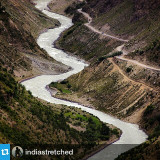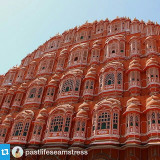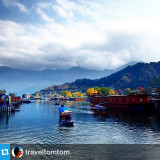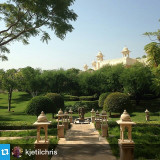Random image from our India photo collection
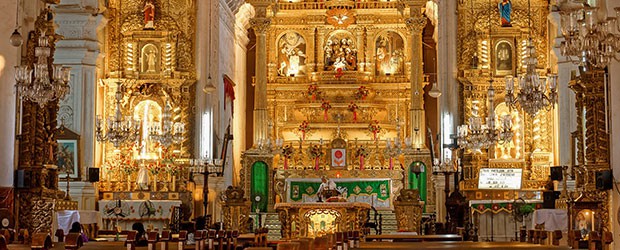
Rajasthan Tourist Centers
The Kanak-vrindavan Valley (restoration Of Splendor)
This is a perfect surrounding for the temples that have been standing here for three centuries. The temple complex consists of the temple of Govind Deoji and Natawarji besides a garden known as the Kanak Bagh.
The temple site is such that the Valley stretches out on one side and the river Dharbawati on the other. This river used to flow across the city of Jaipur but today it has diminished into the lake, Mansagar. This used to be the scared spot where holy water from several rivers was accumulated for the performance of the Ashwamedh yagna.
This enchanting valley with its rich flora and fauna was named Kanak Vrindavan by the ruler and founder of Jaipur, Sawai Jai Singh about 280 years ago. At that time Amber was his capital. The valley had reminded him of Vrindavan, the land of Lord Krishna and soon an idol of Shri Govind Deoji, an incarnation of Lord Krishna, was installed here.
During traditional and religious festivals like Teej and Gangaur, processions coming from Amber, halt at this valley, now considered a symbol of cultural prestige. Today visitors strolling towards the valley can hear strains of bhajans throughout the day. The atmosphere is one of peace and devotion.
But until quite recently the temples and the valley were lying in utter neglect. The walls of the temple had crumbled and ceilings cracked. The intricate jali work, chhatris and arches were badly damaged. The centuries had taken their toll.
Even the flora and fauna had been disturbed by encroachments and stray cattle. The restoration work in the recent past has again made this place a delightful experience. The cool breeze blowing past the chhatris and the aaraish work of the floors takes one by surprise.
The jali work with its essential traditional designs of silver work laid over the lime plaster is a treat to the eyes reminding one of old palaces and castles. The mirror work and panni work for which the artisans of Jaipur are famous, adorns the Garbhagriha, the seat of the Lord.
The deity is seated on a throne. The magnificence and beauty of the Garbhagriha is immense. The intrinsic mirror work forming a backdrop to the idol hypnotizes devotees as in each mirror they see their Lord appearing.
At the entrance of the Garbhagriha lies the parikrama, a small fountain made from a single glistening marble block. The water running from the fountainhead reflects in the mirrors of the Garbhagriha enhancing its beauty.
In between the two temples lies the Kanak Bagh. It is a geometrically designed garden with eight sections, four chhatris and four kabanis all arranged geometrically. A series of fountains adorn the Bagh that is carpeted by lush green grass. There is a baradri - a center stage, from where melodious music fills the valley and visitors are lost in its enchanting impact.
The beauty of the temple of Govind Deoji is further enhanced at night when it is lit up and the entire complex echos with the music and the Lord's aarti sung by the devotees. The temples with their golden luster look heavenly.
Go back
The temple site is such that the Valley stretches out on one side and the river Dharbawati on the other. This river used to flow across the city of Jaipur but today it has diminished into the lake, Mansagar. This used to be the scared spot where holy water from several rivers was accumulated for the performance of the Ashwamedh yagna.
This enchanting valley with its rich flora and fauna was named Kanak Vrindavan by the ruler and founder of Jaipur, Sawai Jai Singh about 280 years ago. At that time Amber was his capital. The valley had reminded him of Vrindavan, the land of Lord Krishna and soon an idol of Shri Govind Deoji, an incarnation of Lord Krishna, was installed here.
During traditional and religious festivals like Teej and Gangaur, processions coming from Amber, halt at this valley, now considered a symbol of cultural prestige. Today visitors strolling towards the valley can hear strains of bhajans throughout the day. The atmosphere is one of peace and devotion.
But until quite recently the temples and the valley were lying in utter neglect. The walls of the temple had crumbled and ceilings cracked. The intricate jali work, chhatris and arches were badly damaged. The centuries had taken their toll.
Even the flora and fauna had been disturbed by encroachments and stray cattle. The restoration work in the recent past has again made this place a delightful experience. The cool breeze blowing past the chhatris and the aaraish work of the floors takes one by surprise.
The jali work with its essential traditional designs of silver work laid over the lime plaster is a treat to the eyes reminding one of old palaces and castles. The mirror work and panni work for which the artisans of Jaipur are famous, adorns the Garbhagriha, the seat of the Lord.
The deity is seated on a throne. The magnificence and beauty of the Garbhagriha is immense. The intrinsic mirror work forming a backdrop to the idol hypnotizes devotees as in each mirror they see their Lord appearing.
At the entrance of the Garbhagriha lies the parikrama, a small fountain made from a single glistening marble block. The water running from the fountainhead reflects in the mirrors of the Garbhagriha enhancing its beauty.
In between the two temples lies the Kanak Bagh. It is a geometrically designed garden with eight sections, four chhatris and four kabanis all arranged geometrically. A series of fountains adorn the Bagh that is carpeted by lush green grass. There is a baradri - a center stage, from where melodious music fills the valley and visitors are lost in its enchanting impact.
The beauty of the temple of Govind Deoji is further enhanced at night when it is lit up and the entire complex echos with the music and the Lord's aarti sung by the devotees. The temples with their golden luster look heavenly.
Go back


